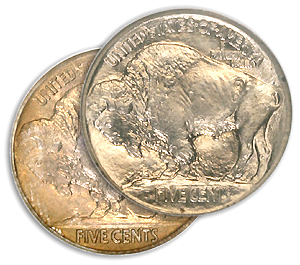|
"Making Cents"
The Signal
Saturday, March 24, 2007
| M |
If one wants to build a collection of these handsome coins, it is not too late — since all of the regular issues can be found at larger coin dealerships and at modest prices.
The scarcer coins, such as the 1913 issues, the mintmarked coins of the teens, the 1921-S, 1926-S and 1931-S are the only other moderately scarce coins in the series. The rare varieties, including the 1916 doubled die, 1918/17-D overdate and 1937-D three-legged variety, can far exceed the cost of a complete set for a single one of these varieties.
I bought my first buffalo nickel album around 1946 when I was in high school, and within a year or so, I filled every slot with coins found in circulation — all at a cost of five cents each.
Some of the early dates had only two digits left in the date, and most would grade as Good or less. The coins from 1934 to 1938 were often in higher grades, such as Very Fine and Extra Fine.
The first issue in 1913 had the buffalo standing on a raised mound. It was evident by mid-year that this feature wore down very quickly, and a second type was issued with a recessed feature showing the denomination (and mintmark, if any). The date, however, was on a slightly raised feature, and it, too, wore down rather quickly — usually starting at the left where the first two digits were. Thus, by the time I started collecting these coins, most had lost half of the date.
The short-lived series was issued annually except for 1922, 1932 and 1933, and only a small number was produced in 1931 — the 1931-S.
It was discovered that by applying a concentrated acid to the dateless coins, the original date can often be made visible. Over the years, I dabbed many of my dateless nickels with this concoction, known as Nik-A-Date, and found a 1918/17-D.
Around 1975, I managed to sell it to a dealer for $10. I am sure that today it would bring 10 times that much or more. My duplicate albums also had many restored-date nickels of various early dates and mintmarks.
Around 1960, someone discovered and verified the first 1918 over 17-D. It has turned out to be one of the truly rare coins in the series, with a current catalogue value of $10,000 in uncirculated conditions.
The 1916 doubled-die date was discovered around 1975. It is considered the rarest variety in the series, with a circulated specimen valued at $5,000 and an uncirculated specimen at more than $20,000.
The uncirculated coins in the teens and twenties are all scarce to rare, and some dates bring many thousands of dollars at auction.
Around 1965, the 1938-D/S (overmintmark) was first published, and unlike the other varieties, it was eventually found to be fairly scarce — but not rare — with uncirculated specimens valued at about $100. A 1936 doubled-die variety had also been discovered, as well as a 1936-D three-legged variety. Both are scarce, but not considered rare.
The most serious collectors would also vie for the matte proof issues of 1913-16, all of which are very expensive, and the proof issues of 1936 and 1937 — again, pretty expensive coins today.
The last two proofs are the best-looking of the coins in the series, and if a collector can afford it, a proof 1937 buffalo is a true gem to own and admire.
Because of its unique design, many high features of the coin either wore down rapidly or, in many cases, the working dies lost some details. Thus, specimens with the strongest features such as the feathers, buffalo horn and lettering at the rim can bring significantly higher prices at auction.
A brilliant uncirculated 1926-D can range from $200 to $5,000, depending on the quality of the images (known as "full strike"). This is true for most mintmarked coins prior to 1931.
As 1931 is my birth year, I pulled out as many 1931-S nickels as I could find, and by the time I joined my first coin club in 1960, I had a full roll of 40 of these scarce coins — now worth $10 each. I managed to sell all of them years ago, however.
One of my regular bank tellers who was alerted to look for certain coins, showed me a roll of nickels a customer had just deposited. It looked to be a few coins shorter than the other rolls of nickels. I bought it, and yes, they were all low-grade buffalo nickels.
Many people who lived through the Great Depression salted away coins — especially buffalo nickels. And among the collections I see today, I often find small to large hoards of these coins, including complete and nearly complete coin folders.
Dr. Sol Taylor of Sherman Oaks is president of the Society of Lincoln Cent Collectors and author of The Standard Guide to the Lincoln Cent. Click here for ordering information.
©2007, THE SIGNAL · ALL RIGHTS RESERVED.

![[Most Recent Quotes from www.kitco.com]](http://www.kitconet.com/images/quotes_special.gif)

